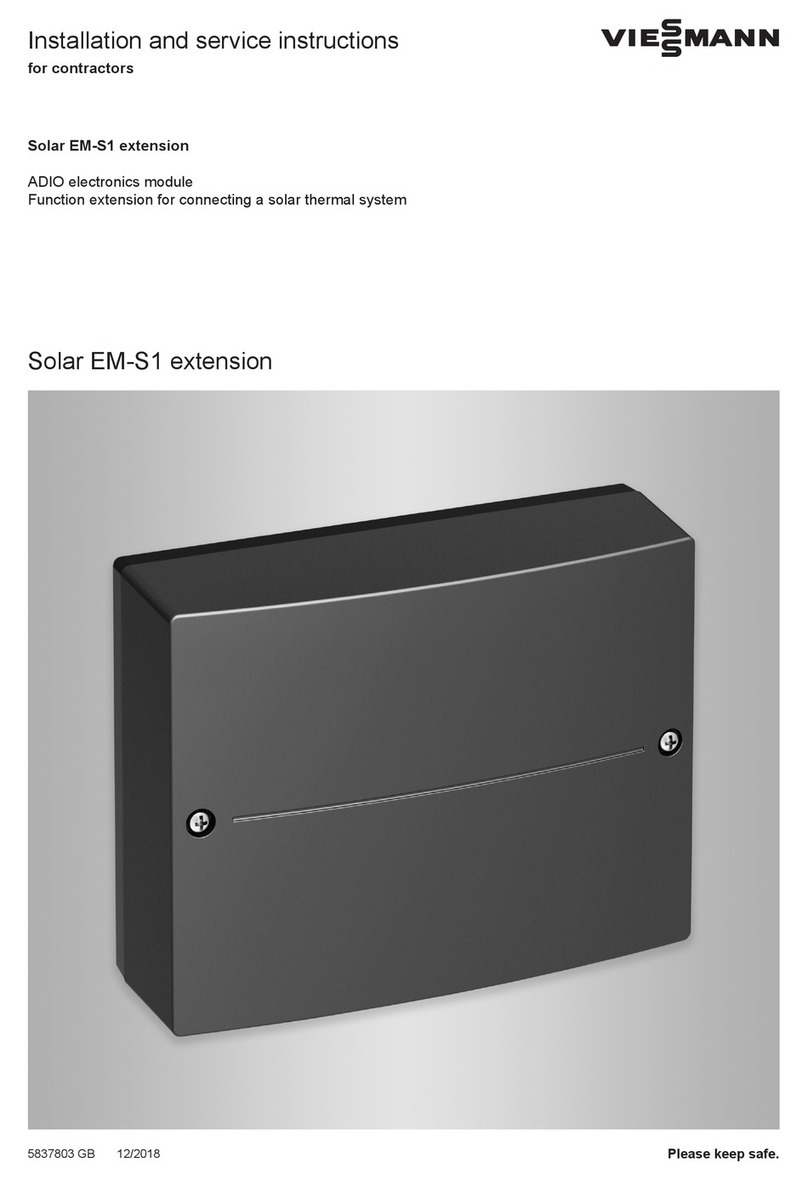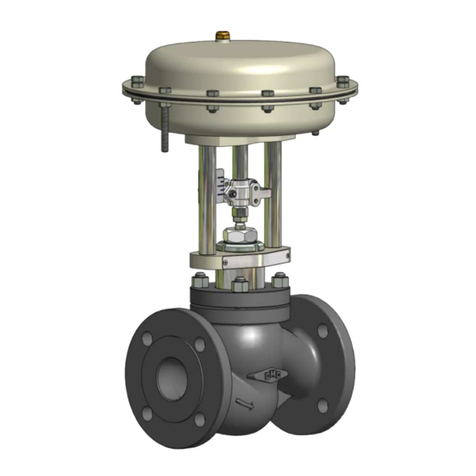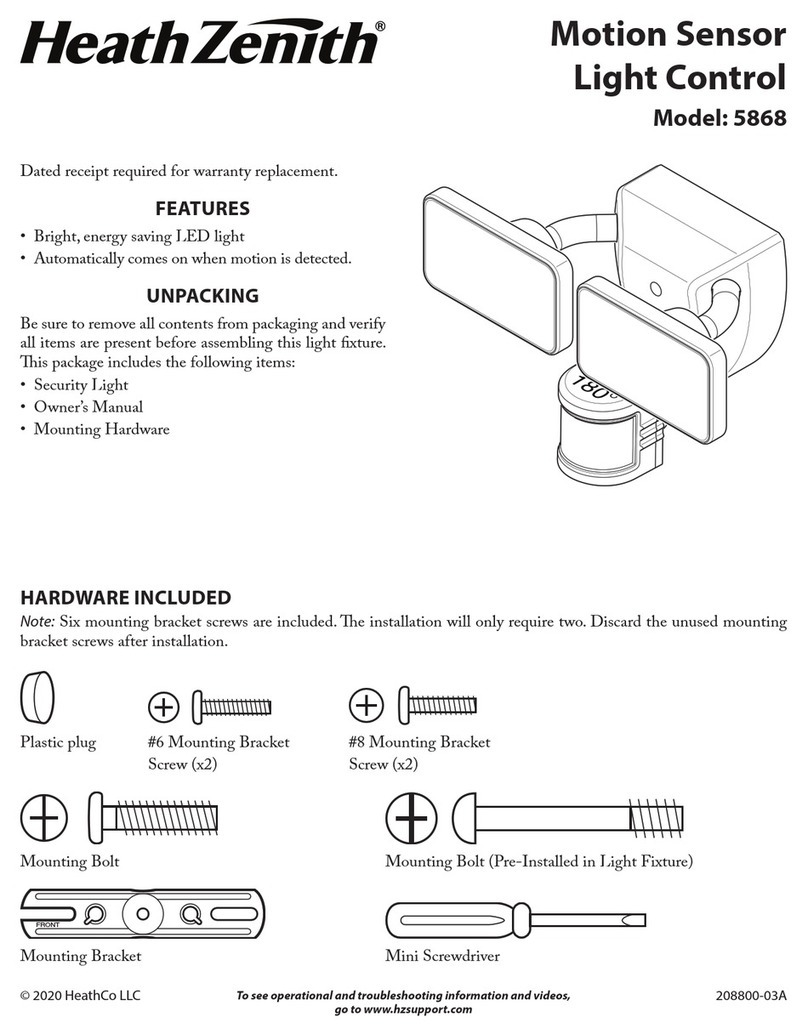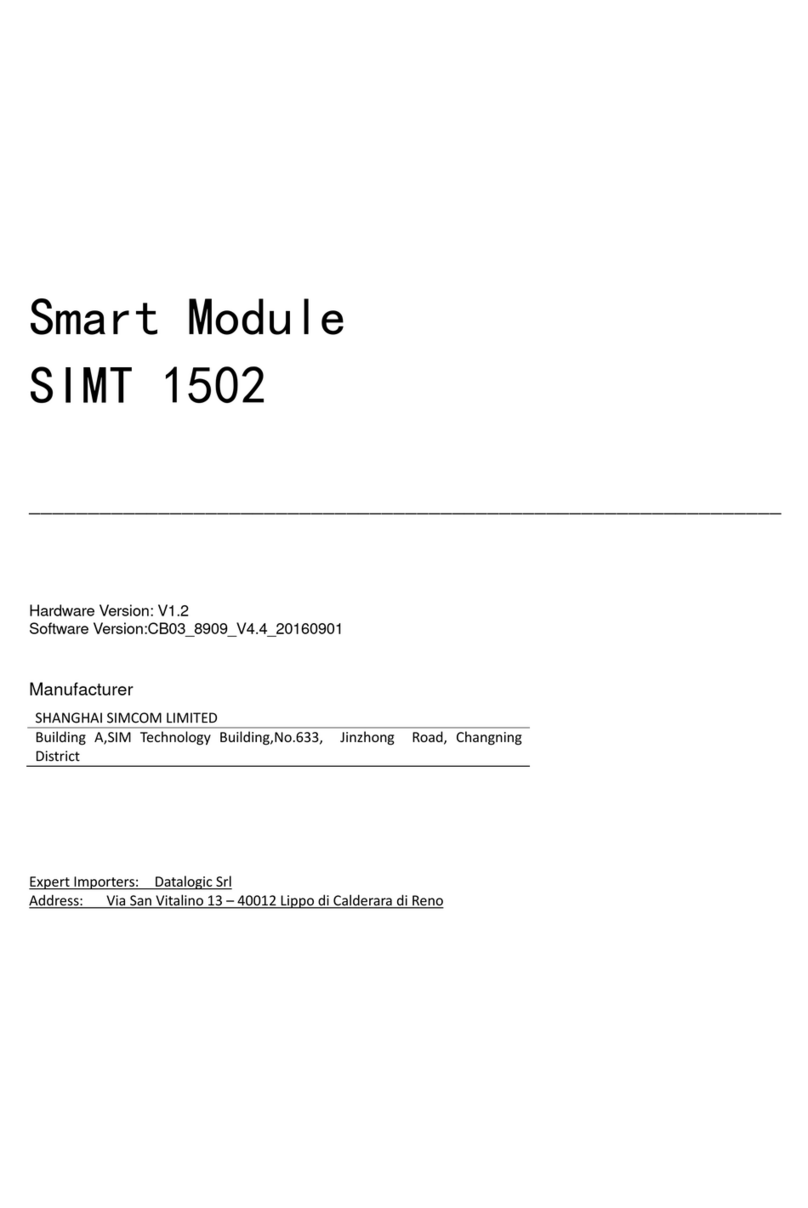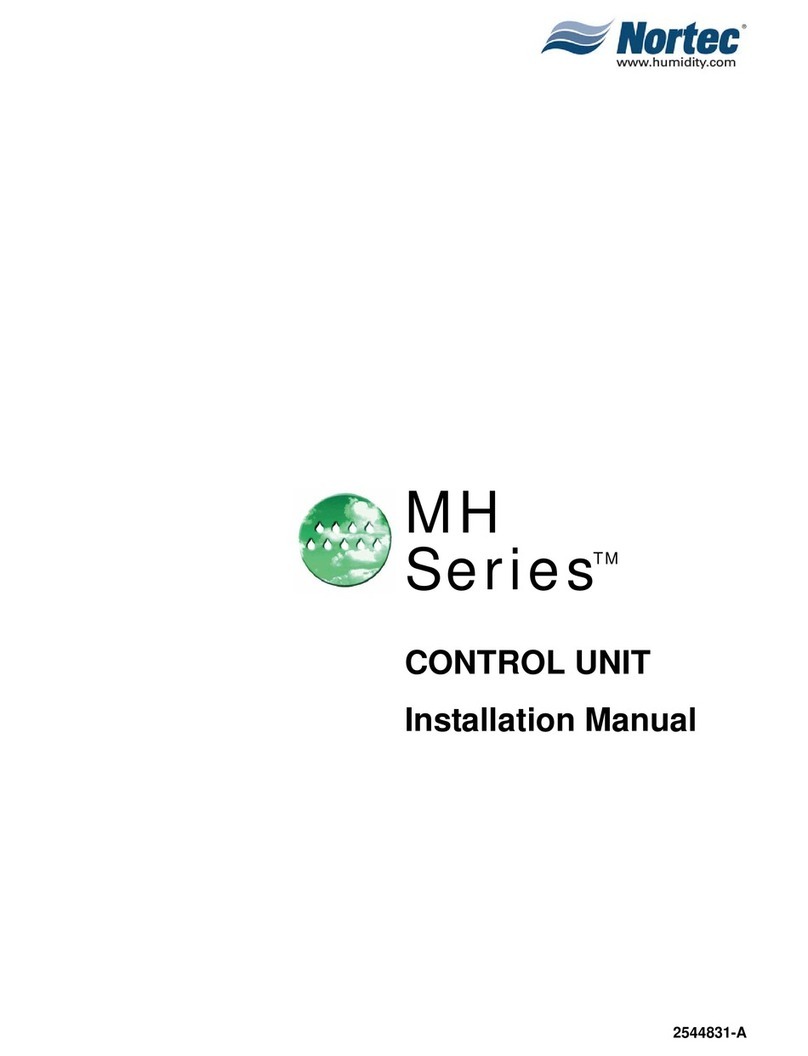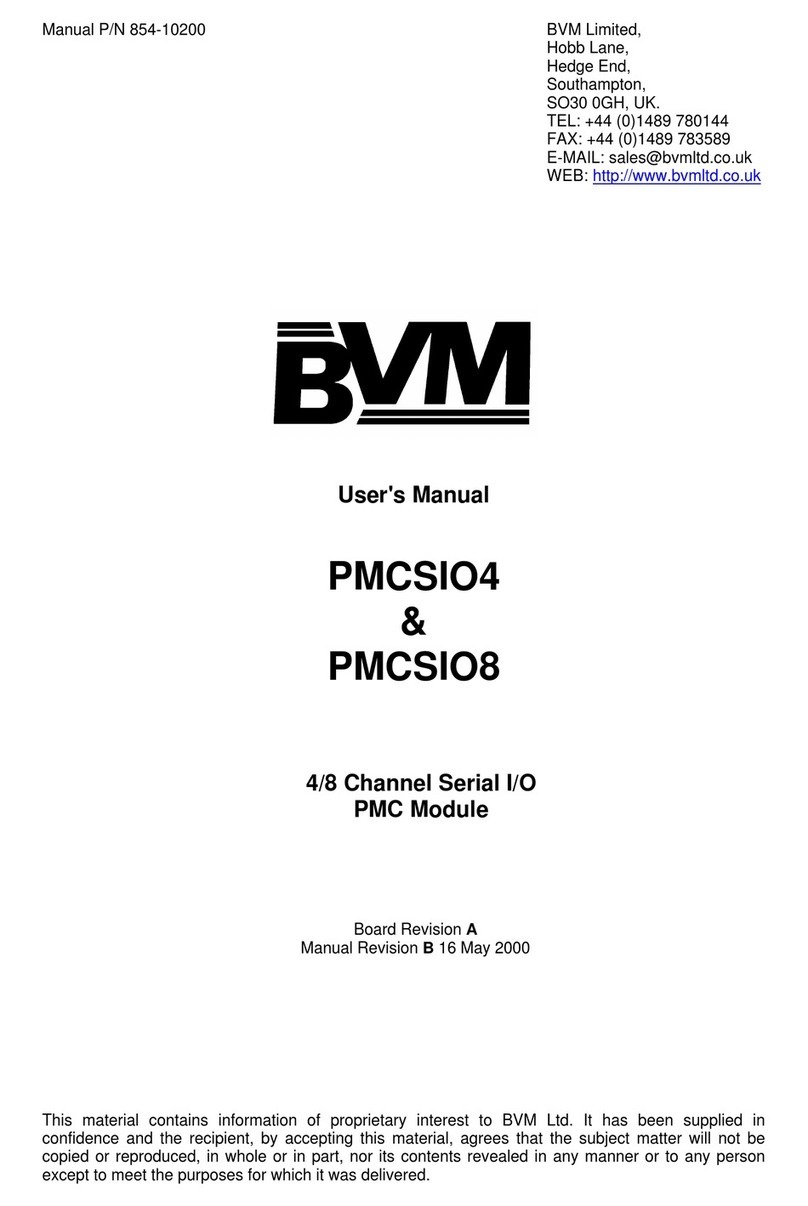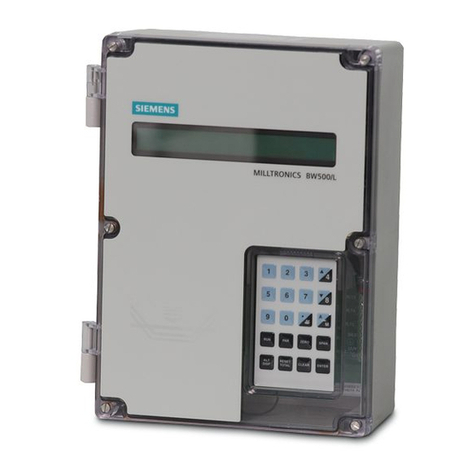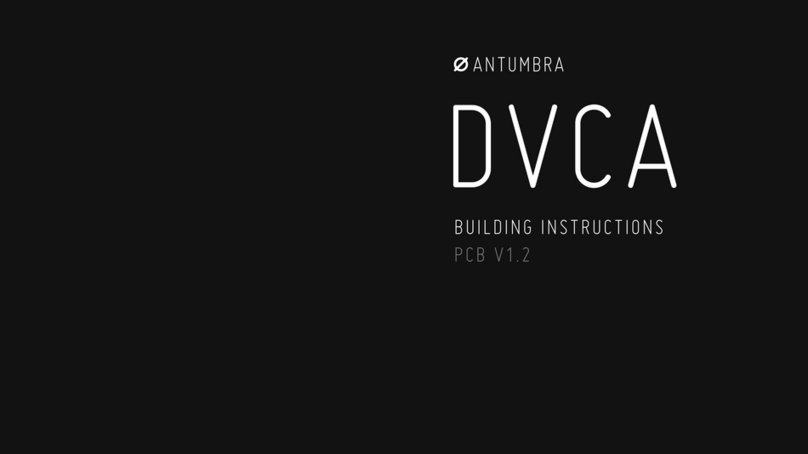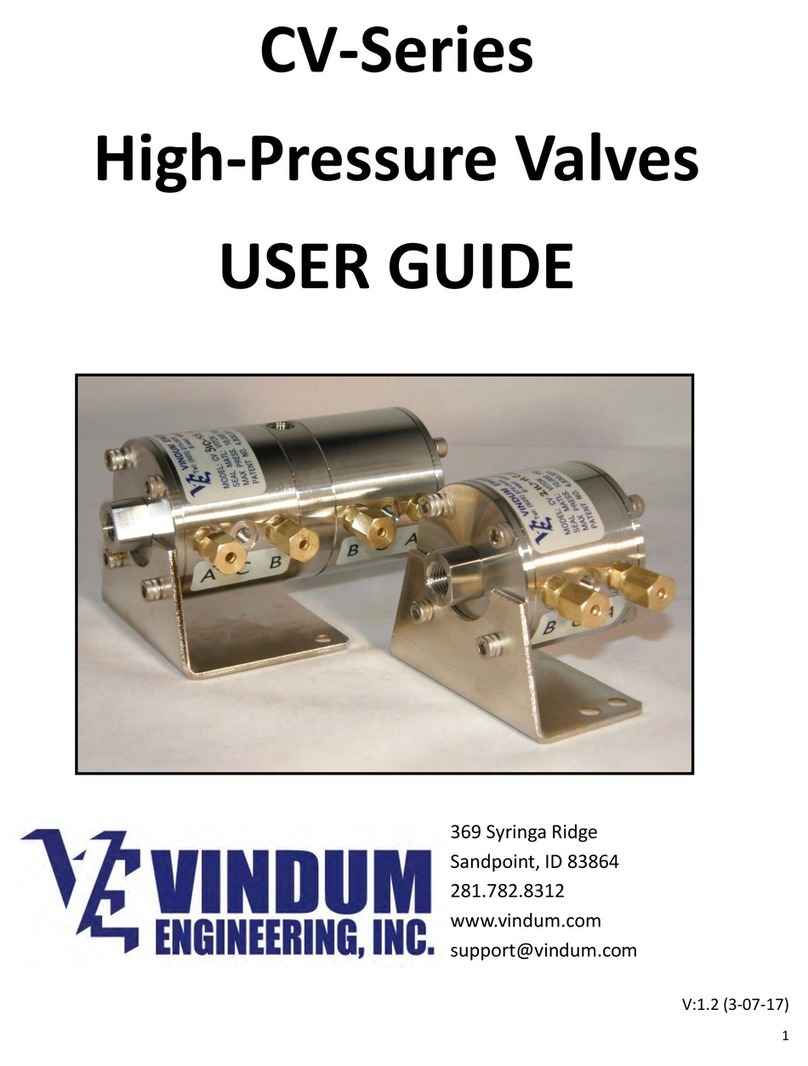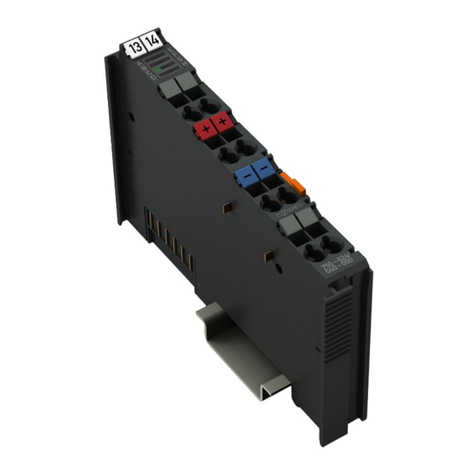ThermoTek PCU User manual

A0011036
June 2020 Rev. 42
Pollution Control Unit
Installation, Operation, and Maintenance Manual
Save these instructions: This document is the property of the owner of this equipment and is required for
future maintenance. Leave this document with the owner when installation or service is complete.
RECEIVING AND INSPECTION
Upon receiving unit, check for any interior and exterior damage, and if found, report it immediately
to the carrier. Also check that all accessory items are accounted for and are damage free. Turn the
blower wheel by hand to verify free rotation. Check the damper (if supplied) for free operation.
WARNING!!
Installation of this unit should only be performed by a qualified professional who has read and
understands these instructions and is familiar with proper safety precautions. Improper
installation poses serious risk of injury due to electric shock, contact with rotating equipment,
and other potential hazards. Read this manual thoroughly before installing or servicing this
equipment. ALWAYS disconnect power prior to working on unit.

2
Table of Contents
WARRANTY ................................................................................................................................................3
LISTINGS ....................................................................................................................................................4
APPLICATION .............................................................................................................................................4
ELECTRICAL ..............................................................................................................................................5
INSTALLATION ...........................................................................................................................................6
Mechanical ............................................................................................................................................6
Site Preparation ..............................................................................................................................6
Joint Sealant .........................................................................................................................................7
Ductwork ...............................................................................................................................................8
Unit Drains ............................................................................................................................................8
Installing Module in Field .......................................................................................................................9
Gasketing .......................................................................................................................................9
Equipment Rails ..................................................................................................................................10
Air Pressure Switch Option .................................................................................................................11
Advanced Filter Monitoring Option ......................................................................................................12
PCU AFM LCD Menus ........................................................................................................................13
Electrostatic Precipitator (ESP) Module ..............................................................................................14
Self-Cleaning ESP ..............................................................................................................................15
LCD Menu Tree ...................................................................................................................................17
Fire System .........................................................................................................................................18
Climate Controlled Utility Cabinet .......................................................................................................19
Bolted Door Design .............................................................................................................................20
OPERATION .............................................................................................................................................20
Troubleshooting ..................................................................................................................................21
PCUAFM Faults ..................................................................................................................................23
MAINTENANCE ........................................................................................................................................24
General Maintenance ..........................................................................................................................24
Filter Information .................................................................................................................................24
2-Weeks After Startup .........................................................................................................................26
Every Month ........................................................................................................................................26
Every 3-Months ...................................................................................................................................26
Yearly ..................................................................................................................................................26
Duct Cleaning ......................................................................................................................................26
Start-up and Maintenance Documentation ..........................................................................................27
Job Information .............................................................................................................................27
PCU Information ...........................................................................................................................27
Advanced Filter Pressure Monitoring Information ........................................................................27
Cleaning & Maintenance Record ..................................................................................................28

3
WARRANTY
This equipment is warranted to be free from defects in materials and workmanship, under normal use and
service, for a period of 2-years from date of shipment. This warranty shall not apply if:
1. The equipment is not installed by a qualified installer per the MANUFACTURER’S installation
instructions shipped with the product.
2. The equipment is not installed in accordance with Federal, State, or Local codes and regulations.
3. The equipment is misused or neglected, or not maintained per the MANUFACTURER’S maintenance
instructions.
4. The equipment is not installed and operated within the limitations set forth in this manual.
5. The invoice is not paid within the terms of the sales agreement.
The MANUFACTURER shall not be liable for incidental and consequential losses and damages potentially
attributable to malfunctioning equipment. Should any part of the equipment prove to be defective in
material or workmanship within the 2-year warranty period, upon examination by the MANUFACTURER,
such part will be repaired or replaced by MANUFACTURER at no charge. The BUYER shall pay all labor
costs incurred in connection with such repair or replacement. Equipment shall not be returned without
MANUFACTURER’S prior authorization, and all returned equipment shall be shipped by the BUYER,
freight prepaid to a destination determined by the MANUFACTURER.
NOTE: To receive warranty coverage for this product, copy and print out the “Start-up and
Maintenance Documentation” on page 27. Fill in all details required. Fax the page to 1-919-516-8710
or call 1-866-784-6900 for email information within thirty (30) days of purchase.
.

4
LISTINGS
This Pollution Control Unit (PCU) is ETL listed to UL-710, CAN/ULC-S646, CAN/ULC-S647 (National Fire
Protection Association Standard “NFPA 96, Standard for Ventilation Control and Fire Protection of
Commercial Cooking Operations”).
ETL/UL listed to UL-8782, and UL-1978/CAN/ULC-S662 (Bolted door design) when installed in
accordance with these installation instructions.
The Electrostatic Precipitator (ESP) module is ETL listed to UL 867, ULC STD C22.2 No. 187; The
Standard for Safety for Electrostatic Air Cleaners.
Approved for use in New York City per the Fire Department of New York Certificate of Approval #5753.
PCU configuration PF-HE-HEPA with optional odor control modules are approved to be used over
commercial charbroiler/ commercial wood cook stove as per NYC DEP # CB2017-0004/CS2017-0001.
PCU configuration HE-ESP-ESP with optional odor control modules are approved to be used over
commercial charbroiler/ commercial wood cook stove as per NYC DEP # CB2020-0001/CS2020-0001.
APPLICATION
The listed Pollution Control Unit is suitable for use in commercial cooking installations for the removal of
smoke and grease laden vapors. This unit is built in accordance to NFPA 96.
Grease duct installations require provisions for cleaning the interior of the duct. NFPA 96 clean-out
requirements are as follows:
1. A clean-out must be provided at each change of direction except where the entire length of duct can be
inspected and cleaned from either the hood or the discharge end.
2. On horizontal duct runs, at least one (1) 20” diameter opening must be provided. Where the opening is
smaller than 20” diameter, openings large enough to permit cleaning must be provided at intervals of
no more than 12’.
3. Openings in the duct must be at the side or the top, whichever is more accessible. When the opening
is on the side of the duct, the lower edge of the opening must be at least 1-1/2” above the bottom of the
duct. For listed grease duct, this is accomplished by the use of the grease manifold tee and clean-out
cap.
4. On vertical duct runs where personnel entry is possible, access must be from the top of the riser.
Where entry is not possible, access must be provided at each floor.
NOTE: Access requirements are subject to change in accordance with local code. Local authorities
should be consulted for exact requirements. Grease ducts may be connected only to hoods in a
single fire zone on one floor. Do not connect grease ducts to any other part of the building
ventilation or exhaust system.
A grease fire can burn at extremely high temperatures. This system should be dismantled and inspected
after any exposure to a grease fire. Any section that is distorted or discolored should be replaced. All joints
in the system should be examined. Because the sealant expands to assure a positive seal in the case of a
fire, any sealant that has been exposed to high temperature must be replaced. This will ensure that the
system maintains its integrity against fire conditions in the future. The manufacturer of this PCU cannot be
responsible for grease duct systems that are not properly maintained or have been subjected to one or
more grease fires. Warranty and listing are void in a fire situation without consulting factory.
Grease duct systems size and capacity information may be obtained from the “ASHRAE Handbook –
Fundamentals” or from the “Air Pollution Engineering Manual” of the “US Environmental Protection
Agency.” Refer to the grease duct systems catalog for descriptions and dimensional data of parts.

5
ELECTRICAL
Before connecting power to the control, read and understand the entire section of this document. As-built
wiring diagrams are furnished with each unit by the factory and are attached to the control module’s door
or provided with paperwork packet.
Electrical wiring (Table 1) and connections must be made in accordance with local ordinances and the
National Electric Code, ANSI/NFPA 70. Verify the voltage and phase of the power supply, and the wire
amperage capacity is in accordance with the unit nameplate. For additional safety information, refer to
AMCA publication 410-96, Recommended Safety Practices for Users and Installers of Industrial and
Commercial Fans.
1. Always disconnect power before working on or near this equipment. Lock and tag the
disconnect switch and/or breaker to prevent accidental power-up.
2. An electrical drop containing the line voltage power wiring is shipped with every unit. The electrical
drop should be brought through one of the conduit openings located in the base of the unit, run
through the curb, and connected to a junction box inside the building. 120V AC should be wired from
terminals H1, N1 in the Electrical Control Package.
3. A dedicated branch circuit should supply the motor circuit with short circuit protection according to the
National Electric Code. This dedicated branch should run to the junction box.
4. Verify that the power source is compatible with the requirements of your equipment. The nameplate
identifies the proper phase and voltage of the equipment.
5. Before connecting the unit to the building’s power source, verify that the power source wiring is de-
energized. Refer to schematics.
6. Secure the power cable to prevent contact with sharp objects.
7. Do not kink power cable and never allow the cable to encounter oil, grease, hot surfaces, or chemicals.
8. Before powering up the unit, make sure that the fan rotates freely. Make sure that the interior of the unit
is free of loose debris or shipping materials.
9. If any of the original wire supplied with the unit must be replaced, it must be replaced with type THHN
wire or equivalent.
WARNING!!
Disconnect power before installing or servicing unit. High voltage electrical input is needed for
this equipment. A qualified electrician should perform this work.
Table 1 - Copper Wire Ampacity
Wire Size AWG Maximum Amps
14 15
12 20
10 30
8 50
6 65
4 85
3 100
2 115
1 130

6
INSTALLATION
It is imperative that this unit is installed and operated with the designed airflow and electrical supply in
accordance with this manual. If there are any questions about any items, please call the service
department at 1-866-784-6900 for warranty and technical support issues.
Mechanical
WARNING: Do not raise PCU by the doors, filter frames, or utility cabinet. Use all lifting lugs
provided with a spreader bar or sling under the unit. Refer to Figure 1.
Site Preparation
1. Provide clearance around installation site to safely rig and lift equipment into its final position. Supports
must adequately support equipment. Refer to manufacturer’s estimated weights.
2. Locate unit close to the space it will serve to reduce long, twisted duct runs.
3. Consider general service and installation space when locating unit.
4. Allow a minimum of 36 inches of clearance on the filter removal side of the unit to replace filters.
5. Support unit above ground or at roof level high enough to prevent precipitation from being drawn into
unit.
6. The PCU is designed to operate in a negative pressure environment. Be sure to install the PCU
between the exhaust fan and hoods. This will also keep the fan cleaner during operation.
7. The PCU drains must be connected to the building grease interceptor or an approved building drain.
Black Iron, Stainless Steel, or Copper Pipe must be used for this connection. If PCU assembly has
Multiple Modules, the drain line must be 2.5 inch NPT pipe minimum.
8. Determine if adequate room is available to install the PCU assembly and all ductwork with proper
clearance to combustible material. Clearance to combustible surfaces to this PCU unit is 18
inches. It is important to check with the local authority having jurisdiction to determine that the
installation method is satisfactory to meet their requirements prior to installation.
9. In the event of a fire system discharge or when a cleaning cycle occurs in the unit, the unit will be
completely flooded with water. When the PCU is installed above or near a finished space, the installing
contractor should protect the finished space, especially when sensitive equipment is below the unit.
Figure 1 - Spreader Bar
Spreader
Bar
Lifting Lugs
Lifting Lugs

7
Joint Sealant
The joint sealant used to seal all joint assemblies is a 3M product. 3M Fire Barrier 2000 + Silicone Sealant
is a ready-to-use, gun-grade, one-component silicone elastomer that cures upon exposure to atmospheric
humidity to form a flexible seal. 3M Fire Barrier 2000 + Silicone Sealant, when installed properly, will
control the spread of fire before, during and after exposure to open flames. It will stop the spread of
noxious gas, smoke, water, and maintain the integrity of fire-rated assemblies and construction.
NO SEALANT SUBSTITUTES MAY BE USED.
Sealant Features
1. Superior adhesion.
2. Capable of withstanding 2000 °F + temperatures.
3. Class 25 sealant, per ASTM C920.
4. Re-enterable/repairable.
5. Provides up to 4-hours fire-rating.
6. Cures upon exposure to atmospheric humidity.
7. Working time 30 minutes.
8. Full cure time: 14 to 21 days.
9. Applied with a standard caulk gun.

8
Ductwork
The ductwork attached to this unit will significantly affect the airflow performance. Flexible ductwork and
square elbows should not be used. There must be at least 3 duct diameters of straight duct leading to
the inlet and at the outlet of the Pollution Control Unit (PCU). Table 2 shows the recommended duct
sizes for optimal performance. The maximum velocity at the inlet of the PCU must be less than 1000
feet per minute for light duty applications and less than 800 feet per minute for heavy duty
applications and solid fuel applications.
Follow SMACNA guides and recommendations for the remaining duct run. Ensure duct connections are
properly aligned and sealed. When the is used in commercial grease ductwork, the ductwork connections
must be FULLY WELDED to the inlet and discharge of the PCU. Ductwork must be listed or installed in
accordance with the IMC. When the PCU is installed in grease rated ductwork, the clearance to
combustible surfaces to this unit is 18 inches.
Table 2 - Recommended Minimum Ductwork Sizes before Transitioning to PCU Inlet
Unit Drains
Each module of the Pollution Control Unit (PCU) contains a drain that must be connected to an
approved grease interceptor or to an approved drainage point. The drain connections must be made
with Black Iron, Copper, or Stainless Steel piping. This will allow the water collected in the unit, either from
Self-Cleaning hood, ductwork cleaning, or from the Core Protection Fire System, to drain away from the
unit. If installed outdoors, the drains must be piped so that water cannot buildup in the pipes and burst due
to freezing. Refer to Figure 2 for details.
• Grease drain must be pitched. Pitch per local code requirements.
• Grease drain line must be connected to the building grease interceptor or an approved drain.
• Grease drain must be at least 2.5” NPT Pipe.
• Grease drain must be made from black iron, copper, or stainless steel pipe.
• P-traps must be installed indoors to prevent drain line from freezing.
Figure 2 - Unit Drain Installation Details
PCU Size Minimum Ductwork Diameter
PCU-1 10”
PCU-2 15”
PCU-3 17”
PCU-4 19”
PCU-5 21”
PCU-6 25”
PCU-7 33”
HIGH
EFFICIENCY
FILTER
TO BUILDING GREASE DRAIN DRAIN LINE MUST BE PITCHED; 1/4" PER FOOT
OUTLET
TO BUILDING GREASE DRAIN
AIRFLOW
PRE-FILTER
INLET
BLOWER/
MOTOR
ACCESS DOOR
ODOR CONTROL
FILTER
HIGH
EFFICIENCY
FILTER

9
Installing Module in Field
Modules are bolted together with 3/8” galvanized hardware, refer to Figure 3. Hardware is shipped with
module. Use anti-seize on bolts to prevent galling. Apply 3M 2000+ Silicone Sealant between modules
before bolting them together, refer to Figure 4.
• Use provided 3/8” galvanized hardware when bolting the modules together.
• Install two spacers on each side, use PC12SPACER or PC345SPACER depending on module size.
Check module door alignment. If module doors are not aligned, remove spacers as needed.
Figure 3 - Field Installation Details
Gasketing
There are two types of gasket used in sealing the PCU, refer to Table 3. The orange gasket is used for
weatherproofing the exterior seams between modules. It is rated at 450° F and has a PSA (Pressure
Sensitive Adhesive) backing. The white gasket is a 1500° F degree gasket that is used to seal all internal
joints in the PCU, including the doors, filter tracks, and inner perimeter between modules. The orange
gasket is applied to the sides and the white gasket is applied at the top of the filter access area to prevent
infiltration. There is a double layer of gaskets between modules, as shown in Figure 4.
Figure 4 - Module Gasketing
Table 3 - Gasket Type Chart
Gasket Type Application Size Temp Rating Part Number
High Temp Closed Cell
(Orange)
Exterior Seam
Between Modules 1/4” x 1” 450°F R-10480-S-1/4"x 1"-15
High Temp Ceramic (White) Internal Seams 1/4” x 1” 1500°F 397-91PSA
3/8” GALVANIZED
HARDWARE
A
TTACH PC12SPACER/PC345SPACER
QUANTITY (2) ON EACH SIDE
SPACERS
450° F Gasket between Modules and doors
1500° F Gasket for Internal Joints
Apply 3M 2000+
Sealant on Ceramic
(White) Gasket.

10
Equipment Rails
The unit should be installed on a curb and/or rail elevated not less than 14 inches above any roof surface.
Secure PCU to rails through vertical portion of the PCU base assembly flange using 1/4”-14 x 1.5” long
self-drilling screws with a minimum of 4 screws per rail. Shims may be required depending upon
equipment rail installation and roofing material. When installed indoors, Unistrut channels may be used
under the PCU for attachment to threaded rod from the roof structure above. Check all fasteners for
tightness. Figure 5 and Figure 6 display different mechanical installation configurations.
Figure 5 - Typical Roof Mount Installation
NOTE: For ESP and size 7 PCU, use the Auto Draw submittal for rail placement and dimensions.
Figure 6 - Typical Indoor (Inline) Installation
NOTE: For ESP and size 7 PCU, use the Auto Draw submittal for rail placement and dimensions.
31-15/16
WEIGHT
48-7/8
32-3/8
66-3/8
97-7/8
52-3/4
81-5/8
21
86-3/8
S
1021 LBS
388 LBS
90-3/8
26-13/16 42-1/8
6"
4-5/8
43-15/16
81-5/8
7-1/2
40-1/2
20"x25"x4" (18)
T
45-1/4
RAIL DIMENSIONS
769 LBS
68
27-11/16 66-3/8
AA
42-5/8
SIZE 6
DIM "T"
48-7/8
44-1/8
1533 LBS
87-1/4
43-15/16
49-1/16
35-1/8
35
5-1/4
1088 LBS
58-3/8 4-5/8
27-11/16
614 LBS
7-1/2
50-1/8
19-7/8
45-1/4
86-3/8
40-1/2
74-7/8
R
53-1/8
28-1/8
26-13/16
LIFTING
LUGS
PRE-FILTER
OUTLET INLET
DIM "R"
85-5/8
101-7/8
91-1/4
85-5/8
F
EQUIPMENT
20 IN HIGH
90-3/8
RAIL
DIM "F"
FILTER
DIM "S"
ODOR CONTROL
DIM "S"
FILTER
HIGH EFFICIENCY
3-3/4
3-3/4
7-1/25-1/4
5-3/4
5-1/4
5-3/4
5-1/4 7-1/2
J
48-7/8
33-7/8
53-1/8
41-7/8
28-7/8
46-1/8 7-1/2
21-7/8
38-1/8 7-1/2
INTAKE OPENING
33
33-7/8
L
26
28-7/8
D
5-3/4
5-3/421-7/8
7-1/2 4-5/8
7-1/2 4-5/841-7/8
4-5/8
5-1/8
48-7/8
DIM "E"
AIRFLOW
3-1/8
DIM "D"
P
DISCHARGE OPENING
H
DIM "AA"
N
DIM "A"
19-7/8
E
SIZE 5
SIZE 4
SIZE 3
SIZE 2
M
DIM "M" DIM "L"
DIM "N"
DIM "P"
K
42-5/8
42-1/8
32-3/8
50-1/8
G
4-5/8
4-5/8
4-5/8
C
SIZE 1
58-3/8
MODEL
51-3/8
UNIT INFORMATION
FILTER SIZE & QTY*
29-3/4
36-3/4
43-3/8
UNIT DIMENSIONS
3-1/8
5-1/8
20"x25"x4" (3)
B
20"x25"x4" (6)
20"x25"x4" (8)
20"x25"x4" (10)
20"x25"x4" (12)
DIM "C"
DIM "H"
A
DIM "G"
32-1/8
DIM "J"
32-1/8
DIM "K"
38-1/8
DIM "B"
35-1/8
DIM "AA"
35-1/8
WEIGHT
27-3/8
51-5/8
41-3/8
51-5/8
59-3/16
29-1/8
20"x25"x4" (18)
ODOR CONTROL
7-1/2
32-3/8
5-1/4
R
OPTIONAL
66-3/874-7/8
80
66-3/8
90-3/8
50
LIFTING
LUGS
33-1/8
91-1/4
27-11/16
27-11/16
OUTLET
27-13/16
FILTER
96
42-1/8
58-3/8
UNI-STRUT SUPPORT
AA
78
36-1/8
1" TYP
33-1/8
101-7/8
S
7-1/2
31-15/16
DIM "S"
27-13/16
PRE-FILTER
28-11/16
DIM "F"
UNI-STRUT BASE
42-5/8
53-1/8
T
64
36-1/8
F
36-1/8
85-5/8
28-1/8
4-5/8
28-11/16
DIM "R"
HIGH EFFICIENCY
50-1/8
1" TYP
FOR HANGING
DIM "T"
19-7/8
90-3/8
78
4-5/8
39-1/8
85-5/8
26-13/16
35-1/8 48-7/8
26-13/16
SIZE 6
INLET
48-7/8
32-15/16
1533 LBS
FILTER
7-1/2
38-1/8 7-1/2
DIM "A"
33
33-7/8
26
28-7/8
D
5-3/4
AIRFLOW
5-3/421-7/8
4-5/8
4-5/8
4-5/8
1088 LBS
5-1/8
1021 LBS
DIM "D"
3-1/8
769 LBS
614 LBS
P
388 LBS
DISCHARGE OPENING
NM
DIM "AA"
E K
3-3/4
3-3/4
5-1/4
5-1/4
5-1/4
DIM "E"
7-1/248-7/853-1/8
41-7/846-1/8
7-1/2
5-3/4
DIM "N"
5-3/4
J
33-7/8
28-7/8
21-7/8
INTAKE OPENING
L
7-1/2
7-1/2
41-7/8
48-7/8
DIM "P"
SIZE 5
SIZE 4
SIZE 3
SIZE 2
DIM "M" DIM "L
"
H
19-7/8
42-5/8
42-1/8
32-3/8
50-1/8
G
4-5/8
4-5/8
4-5/8
C
58-3/8
51-3/8
DIM "H"
29-3/4
36-3/4
43-3/8
UNIT DIMENSIONS
DIM "AA"
3-1/8
5-1/8
SIZE 1
MODEL
B
UNIT INFORMATION
DIM "G"
FILTER SIZE & QTY*
A
32-1/8
32-1/8
38-1/8
35-1/8
35-1/8
20"x25"x4" (3)
20"x25"x4" (6)
20"x25"x4" (8)
20"x25"x4" (10)
20"x25"x4" (12)
DIM "J"
WEIGHT
DIM "C"
DIM "K"
27-3/8
51-5/8
41-3/8
51-5/8
59-3/16
DIM "B"

11
Air Pressure Switch Option
Switches are preset from plant to 0.15” w.c. above the internal static pressure of the PCU with clean filters.
An air pressure switch, refer to Figure 7, is located in the downstream filter module.
Route wiring from hood control panel to PCU using 1/2” conduit through quick seal located near lower right
area of filter module containing switch. Use existing conduit in module to route wires from exterior of
module to switch. Install wiring according to label above switch. Be sure all conduit fittings are tight. Once
filters become clogged, switch closes illuminating light in kitchen. User should then clean or replace filters
as required. Refer to Figure 8 for more details.
Figure 7 - Differential Pressure Switch
Figure 8 - Airflow Switch Installation
Pressure Switch Wiring
Power
In 32
To
Light
SWITCH IS MOUNTED USING 4
#8 x 1/2" PAN HEAD SHEET
METAL SCREWS
AIR PROBE
MACOLA # 17045
PART # 17045
INLINE QUICK CONNECT
MACOLA # 8167
PART # 5523K72
AIR PROBE MOUNTED
IN E*PCBFBL-V2 OF FIRST
FILTRATION MODULE
FACING TOWARD
INTAKE AND DOWN
INLINE
THROUGH WALL
CONNECTER
PART #
5148K193
AIR LINE ROUTING NOT
TO SCALE
FILL ALL BLANK HOLES IN
BFBL WITH RIVETS
AIR LINE ROUTED
TOWARD EXHAUST
1/4" EXTREME
TEMP AIR LINE
MACOLA#8165
PART #5239K12
AIR LINE ROUTED TOWARD
INTAKE
Will Pass through
additional modules BFBL
INLINE THROUGH
WALL QUICK CONNECT
INSTALLED IN BFBL OF
ALL MIDDLE MODULES
DIFFERENTIAL AIR PRESSURE SWITCH
Set Point <1.8" MACOLA # 17047
PART #ADPS-03-1-N
Set Point > 1.8" MACOLA # 17049
PART #ADPS-05-1-N
SWITCH SET-POINT PER PCU PAPERWORK
1/2" LIQUID TIGHT CONDUIT USED
TO ROUTE WIRES FROM SWITCH TO
QUICK SEAL AT EXTERIOR OF UNIT
WITH 90 DEGREE FITTINGS AT ENDS
AIR LINES MUST POINT DOWN
ROTATE SWITCH COVER SO
CONDUIT ENTERS FROM TOP RIGHT
OF SWITCH
INLINE QUICK CONNECT
MACOLA # 8167
PART #5523K72
SWITCH WIRING LABEL
LOCATION
1/2" QUICK SEAL
MACOLA # 371
PART # 32-00002

12
Advanced Filter Monitoring Option
The PCU Advanced Filter Monitoring board (PCUAFM), Figure 9, utilizes proprietary algorithms to make
determinations about filter loading percentages as well as fault conditions, such as missing filters and
missing doors. These algorithms take into consideration known characteristics and interactions of many
specific filter combinations, stored calibration values derived from measurements taken at the time of test
and balance, and measurements of the dynamically changing current operating conditions such as
demand ventilation. Personnel servicing the PCU have direct access to operating characteristics and fault
conditions through the use of a LCD screen, which is conveniently located directly on the PCUAFM board.
Accurate monitoring of PCU filter conditions not only ensures proper operation of the PCU, but can also
reduce the operating cost of the PCU by reporting the condition of each individual filter module. This can
eliminate the needless replacement of filters that have not yet reached the end of their useful life.
Figure 9 - Advance Filter Monitoring System
Features and Benefits:
• Monitors pressure drop across each filter module of the Pollution Control Unit (PCU).
• Detects Missing Filter and Missing Door condition.
• Detects Filter Clogged condition.
Several techniques are employed to ensure the validity of the pressure readings. Consequently
disturbances caused by events such as fan starting and stopping, filter door removal and sudden changes
in building or atmospheric pressure will cause a delay in updating the faults until the disturbances have
subsided and enough fresh data has been gathered.
The filter monitoring system has 8 ports (Table 4) which are used based on the number of filter modules in
the PCU assembly. The following chart shows the port connections used for different PCU configurations.
PORT 7 is used only if the PCU assembly has a blower installed. The unused ports remain exposed to the
space in the cabinet. Port 8 (Atmospheric Port) is used to measure ambient pressure, external to the PCU.
Table 4 - PCUFMM Port Connections
No. of PCU Filter
Modules Port 1 Port 2 Port 3 Port 4 Port 5 Port 6 Port 7 Port 8
1 Yes Yes No No No No Yes/No Yes
2 Yes Yes Yes No No No Yes/No Yes
3 Yes Yes Yes Yes No No Yes/No Yes
4 Yes Yes Yes Yes Yes No Yes/No Yes
5 Yes Yes Yes Yes Yes Yes Yes/No Yes

13
PCU AFM LCD Menus
Following are the various menus that appear in sequential order during navigation through the LCD
screen.
•Pollution Control Unit - This is the start-up screen when the unit is turned on.
•Filter Status - Displays percentage of filter clogging for up to 5 filter modules or “MISSING” if a
module’s filters are missing. “CALIBRATION REQUIRED” will be displayed if the calibration sequence
has not been completed upon PCU unit start up.
•Pressures - Displays pressure drop for up to 5 filter modules, the total pressure drop (TOT) across the
PCU, PCU inlet static (IN) and discharge pressure (OUT).
•Temperature - Sensor on the circuit board displays relative temperature of the cabinet that houses the
controls.
•Faults - “NO FAULTS” are displayed if the PCU is functioning as desired. Refer to “PCUAFM Fault
Chart” on page 23 for faults and descriptions.
•Reset Faults - Once a fault is activated and the necessary corrected action is taken this menu choice
is selected to clear the fault.
•Calibration - MUST be performed after PCU unit start up or with any PCU or Hood Filter configuration
change. Calibration is ALWAYS performed with clean PCU filters. A 4 digit PIN (1234) is entered using
the board buttons. Once entered correctly, the new filter calibration sequence is started.
“CALIBRATING” will be displayed until calibration is complete. A percentage complete will also be
displayed. Fan speed must be maintained at 100% for the entire calibration time. If fluctuations are
detected the calibration sequence will restart from zero percent.
•Configuration - The PCU is configured at the factory. The PCU has to be re-configured ONLY if filter
types in any filter module are changed. To enter the configuration menu, use the board buttons to input
the required 4 digit PIN (5678).
The following sub menus are available under the “CONFIGURATION” menu:
- CFG PCU Modules - This sub menu steps through the process of configuration. Module count for
the PCU assembly is entered followed by the filter type for each module.
- PCU Number - The number for this PCU will be displayed in reverse video and is selected using the
board buttons. This number allows for up to 8 PCUs to exist on one Modbus network.
- Inlet Pressure Variation - Allows the user to adjust the variation in inlet pressure for faults to be
detected by the PCU. The default parameter setting is 15%, i.e. if the pressure at the inlet of the
PCU drops by more than 15% of the calibrated value due to changes in inlet conditions like Missing
Hood Filters or Open Duct Access doors, all faults on the PCU except “MISSING DOOR” will be
IGNORED.
- Calibration Values - Allows the user to change stored calibration values. Upper and lower limits for
filter module pressures are set at 5.000” and 0.000”. Upper and lower limits for inlet pressure are set
at -0.001" to -5.000", and upper and lower limits for outlet pressures are set at 5.000” and -5.000”.
- Discharge Threshold - Allows the user to change the discharge threshold to help detect MISSING
DOOR fault. Default value is set at 0.100”.
The “Inlet Pressure Variation” percentage, “Edit Calibration” and “Discharge Threshold” setting can be
changed anytime without the need to recalibrate the unit.
- ESP Min Inlet Pressure - Allows the user to adjust minimum inlet pressure that the high voltage
power supply will turn ON. Range is 25-80%. Default is set to 25%.
- ESP Max Inlet Pressure - Allows the user to adjust maximum inlet pressure that the high voltage
power supply will remain ON. Range is 100-150%. Default is set to 120%.
- ESP Delay After Wash - This setting determines how long the high voltage power supply is OFF
after a self-cleaning cycle has completed. This duration allows the unit to dry. Range is 90 – 240
minutes. Default is set to 120 minutes.
• Information - This menu displays filter type for up to 5 modules, software, revision, number of filter
modules currently selected, calibration info for filter modules selected, inlet calibration value, discharge
calibration value, inlet pressure variation setting and discharge threshold limit.

14
Electrostatic Precipitator (ESP) Module
NOTE: The ESP module requires a Pollution Control Unit that contains an Advanced Filter
Monitoring (AFM) board. The PCUAFM board powers the ESP cell(s) and provides the user with
safety features. Verify that the system is wired per unit schematic located on module door.
The ESP is an optional electronic air cleaner filtration module. Airborne particles pass through a series of
high voltage plates. These particles become ionized and are collected at the collection plates. Always
verify the cells are installed correctly. Make sure the directional arrow is with the unit’s airflow. The ionizer
stage will always face the air inlet side of the unit. Refer to Figure 11 for cell details.
Figure 10 - ESP Module Components
Refer to Figure 10 for ESP component
layouts.
1. High Voltage Power Supply - 13K
VDC to the ionizer. 7K VDC to the
collector.
2. LED Light - LED light to indicate if
high voltage power supply is ON.
3. Disconnect Switch
4. PCUAFM Control Cabinet
5. ESP Cabinet Door Switch
(Door shown removed)
6. ESP Cell Switch - Monitors if the
ESP cell is present or not.
The ESP module uses one power supply per row of ESP Cells. Size 1 and 2 units will use one power
supply. Size 3 through size 6 units will use two power supplies. Size 7 units will use three power supplies.
The high voltage power supply contains a potentiometer. This is set at the highest voltage setting. The
power supply uses high voltage wire leads rated to 20K VDC.
The LED is operated by 24V AC. There is one light per power supply. When the light is ON (green), this
indicates that the power supply is functioning properly (no short circuits and that the cells are energized).
Figure 11 - ESP Cell
WARNING!! ELECTRIC SHOCK RISK
Servicing this unit should be performed by qualified personnel only. To reduce risk of injury, do
not perform any servicing other than that contained in the operating instructions unless you are
qualified to do so. Wait at least 30-seconds after ESP is de-energized before accessing any high
voltage components. This will allow for the cells to discharge.
4
12
3
5
6
Collection Stage (Smooth Flat Plates)
Maximum Collector Voltage +7K VDC
Ionizer Stage (Metal Spike Plates)
Maximum Ionizer Voltage +13K VDC
Make sure when installing the cells
that the spiked plates are located on
the air entrance side.
Conical springs are placed on the
two contacts which align with the
contacts on the PCU door. If there
are multiple cells, springs are
located between cells. All spring
contacts are placed on the front
side of cell.
Contact
Conical
Spring

15
Self-Cleaning ESP
The ESP module is equipped with an internal self-cleaning system for cleaning the cell(s). There are two
options to operate the self-cleaning system; with a Demand Control Ventilation (DCV) package or with a
dedicated Self-Cleaning System (SCS) package. Figure 12 is a default self-cleaning sequence operation.
The following faults are ignored during a self-cleaning cycle and when “ESP Delay After Wash” timer is
active: Filter Missing, Filter Clogged, PCU Clogged, 24 Hour Clog, and 72 Hour Clog, and Filter Status “%
Clogged” values are not calculated during this period.
Figure 12 - Self-Cleaning Sequence
The “ESP Delay After Wash” is activated by a 120V AC signal. After the PCUAFM board stops receiving
the 120V AC signal, the “ESP Delay After Wash” timer is activated (default is set to 120 minutes). During
the self-cleaning cycle and when the “ESP Delay After Wash” timer is active, voltage to the high voltage
power supply(s) will shut OFF. Cell(s) will resume normal function after the “ESP Delay After Wash” timer
has expired. The PCUAFM screen and DCV/SCS HMI screen will display “ESP Dry Mode” when the “ESP
Delay After Wash” timer is active. Following the self-cleaning cycle, “ESP Dry Mode” forces fans ON (high
frequency for dynamic zone).
For third party fan control, a multifunction timer is provided and is factory set to 120 minutes. A dry contact,
located in the PCUAFM control cabinet, is used to force the fans on (controlled 120V AC signal from
PCUAFM to the timer).
The module has a NPT connection on the backside of the unit for self-cleaning refer to Figure 13. The
maximum water operating pressure during self-cleaning is 100 PSI. The minimum water pressure during
self-cleaning is 20 PSI. The water temperature range should be 140°F to 170°F.
Figure 13 - Water Inlet Connection
If the PCU is mounted outdoors, heat tape must be applied to all external piping for the ESP Self-
Cleaning System (SCS). If a self-draining SCS package is used, heat tape is not necessary.
The ESP module contains a drain. If the drain should ever become clogged, the float switch will activate a
fault. When a fault is active, power to the ESP power supply will be turned OFF. Refer to applicable
manual for self-cleaning details.
Self-Cleaning Spray
Water and surfactant will
spray the ESP cells.
Drain Period
Unit will drain water
and surfactant.
Dry Mode
Fan is forced ON to the high
frequency setting.
Start
0 Seconds 3 Minutes 8 Minutes Finish
128 Minutes
Default Duration: 3 Minutes
Range: 1-15 Minutes
Duration: 5 Minutes
Not Adjustable
Default Duration: 120 Minutes
Range: 90 Minutes to 240 Minutes
NPT Water Inlet Connection
for Size 1 and 2 units.
NPT Water Inlet Connection
for Size 3 through 7 units
NOTE: Size 1-5 units use
a 1” NPT connection.
Size 6 and 7 units use a
1-1/2” NPT connection.
NOTE: Self cleaning
manifolds have
factory-installed plugs to
prevent field debris from
entering the lines.

16
The discharge coefficient, or “K Factor”, is used to calculate the actual GPM through the system when the
incoming pressure is different than what is specified in Table 5. This K factor can be applied to the
completed ESP self-cleaning assembly. The formula below will provide the Gallons per Minute discharge
rate of the self-cleaning assembly. Table 5, Table 6, and Table 7 are based on the self-cleaning ESP
minimum operating pressure of 20 psi.
Total Flowrate = K Factor * Pressure0.44
Table 5 - Self-Cleaning Water Consumption Based on PCU Size in GPM
PCU Size # of ESP Modules
1 Module 2 Modules
PCU 1 2.3 4.6
PCU 2 5.3 10.6
PCU 3 7.6 15.2
PCU 4 10.6 21.3
PCU 5 10.6 21.3
PCU 6 16.7 33.4
PCU 7 25.1 50.1
Table 6 - Self-Cleaning Discharge Coefficient (K-Factor)
PCU Size # of ESP Modules
1 Module 2 Modules
PCU 1 0.6 1.2
PCU 2 1.4 2.8
PCU 3 2.0 4.1
PCU 4 2.8 5.7
PCU 5 2.8 5.7
PCU 6 4.5 8.9
PCU 7 6.7 13.4
Table 7 - Quantity of Self-Cleaning Nozzles Installed
PCU Size # of ESP Modules
1 Module 2 Modules
PCU 1 3 6
PCU 2 7 14
PCU 3 10 20
PCU 4 14 28
PCU 5 14 28
PCU 6 22 44
PCU 7 33 66

17
LCD Menu Tree
POLLUTION CTRL UNIT
(sw revision)
FILTER STATUS FILTER # 1-5
% CLOGGED
CALIBRATION REQUIRED
(if unit is not calibrated)
PRESSURES
FILTER 1-5 INSTANTANEOUS PRESSURE DROPS
TOT (total pressure drop)
OUT (outlet pressure)
IN (inlet pressure)
TEMPERATURE °F/C
FAULTS
NO FAULTS
CALIBRATION REQUIRED
FILTER CLOGGED
FILTER MISSING
MISSING DOOR
PCU CLOGGED
24 HOUR CLOG
72 HOUR CLOG
ESP/DOOR MISSING
ESP DRAIN CLOG
RESET FAULTS FAULTS CLEARED
PRESS ANY KEY
CALIBRATION ENTER PIN
(1234)
CAL. COMPLETE
PRESS ANY KEY
CONFIGURATION ENTER PIN
(5678) CFG PCU MODULES MODULE COUNT 1-5 MODULE #
FILTER TYPE FILTER CONFIGS. SAVED
PCU NUMBER RANGE: 1-8
DEFAULT: 1
PCU # SAVED
PRESS ANY KEY
INLET PRESSURE
VARIATION
RANGE: 10-90%
DEFAULT: 15% SETTINGS SAVED
EDIT CALIBRATION
VALUES
FILTER 1-5 PRESSURES RANGE: 0.000” to 5.000”
DISCHARGE PRESSURE RANGE: -5.000” to +5.000”
INLET PRESSURE RANGE: -5.000” to -0.001”
SETTINGS SAVED
PRESS ANY KEY
EDIT DISCHARGE
THRESHOLD EDIT VALUE RANGE: 0.000”-5.000”
DEFAULT: 0.100”
INFORMATION FILTER INFO
(1-5)
GENERAL INFO SW REV
MODULES
CONFIG #
PCU #
CRC
CALIBRATION INFO
FILTER 1-5
TOT
IN
OUT
GENERAL INFO INLET
OUTLET
EDIT ESP MIN. INLET
PRESSURE EDIT VALUE RANGE: 25-80%
DEFAULT: 25%
EDIT ESP MAX. INLET
PRESSURE EDIT VALUE RANGE: 100-150%
DEFAULT: 120%
EDIT ESP DELAY
AFTER WASH EDIT VALUE RANGE: 90-240 MINUTES
DEFAULT: 120 MINUTES
SETTINGS SAVED
PRESS ANY KEY
SETTINGS SAVED
PRESS ANY KEY
SETTINGS SAVED
PRESS ANY KEY
SETTINGS SAVED
PRESS ANY KEY
Only for units with
ESP Module

18
Fire System
Pollution Control Units require a fire system to be installed for Type 1 applications. Current International
Mechanical Code (IMC) requires that the fire system be installed by the manufacturer (2018 IMC). CORE
and EWC fire systems are available for the PCU. PCU fire systems use electric sensors set at 360°F to
activate the fire system. Outdoor EWC Systems require a climate controlled utility cabinet to ensure that
the fire system does not drop below 32°F and does not exceed 130°F. See below for more information
about outdoor installations. It is highly recommended that the PCU fire system be interlocked to the
corresponding hood fire system so that if the hood system activates, the PCU system activates. Reverse
activation requirements are determined by local code or at the discretion of the Authority Having
Jurisdiction, but are recommended for safety.
In the event that the fire system is accidentally activated, all disposable filters must be replaced and the
pre-filter cleaned. The water or chemical agent used in the fire system can cause the filters to fail
prematurely.
In the event that a fire occurs in the ductwork leading to the PCU or inside the PCU, the following must be
completed.
• The unit must be cleaned of all fire suppression chemicals and grease.
• The filters must be replaced, this includes the pre-filter.
• If an ESP module is present, the ESP cells must be removed, and cleaned in warm soapy water. Wash
cells until all chemical residue is removed. ESP pre and post filters must be replaced. When re-
installing cell(s), make sure to install with the airflow in the correct direction as indicated on the cell.
• If any of the gasketing is damaged, replace the gasketing between modules and between the doors.
• If any of the components that make-up the Pollution Control Unit are damaged by fire, then that
component must be replaced and inspected by factory trained service personnel.
Installation, commissioning, or resetting of the fire system must be done by a licensed fire system
installer. Use the guidelines set forth by the appropriate fire system manual; PCU with CORE Fire
Suppression System manual, Model EWC (Electric Wet Chemical) Extinguishing System, or other
fire system manufacturer.
For electric wet chemical fire systems for PCU, external piping that connects the PCU fire system nozzles
to the fire system tanks is factory-installed using Grade L 1/2” copper tubing and pro-press fittings. If a
remote (wall mount) EWC fire system is utilized, distribution piping shall be Grade L 1/2” copper tubing and
pro-press fittings or 3/8” NPT Schedule 40 black iron, chrome-plated, or stainless-steel pipe and fittings. If
distribution piping is exposed to an outdoor environment it must be Grade L 1/2” copper tubing and pro-
press fittings or 3/8” NPT Schedule 40 stainless-steel pipe and fittings.

19
Climate Controlled Utility Cabinet
For outdoor installations, a climate controlled cabinet is available to house the fire system, refer to
Figure 14. This box contains a heater, an exhaust fan, and thermostats to control the temperature inside
the cabinet. The Utility Cabinet thermostats come preset to heat below 40°F and cool above 90°F. The
climate controlled cabinet requires a dedicated 15 amp, 60 Hz, 115 volt, single phase electrical service.
Refer to Figure 15 for typical climate control utility cabinet schematic.
Figure 14 - Pollution Control Unit with Climate Controlled Utility Cabinet
Figure 15 - Typical Wiring Schematic for Climate Controlled Utility Cabinet
Utility Cabinet
LINE
BK
WH
W
MT-02
TS-01
120VAC 15 AMPS
RD
WH
YW
TS-02
SW-01
1 2 BK
NEUTRAL
GR
HS-01
MT-01
RB
WH
W
BL
HS-02
RB
3 4

20
Bolted Door Design
A bolted door design is an optional construction version of the PCU to meet UL1978 requirements. The
PCU bolted door design contains the following parts:
• High Temperature (Orange) Gasket - Part number R-10480-S-1/4” x 1”-15
• 1/4”-20 Bolts - Part number 0122323.0800
• Cage Nuts - Part number 11626-03224
The high temperature (orange) gasket is applied on the door jambs, refer to Figure 16.
Prior to closing the door, make sure all cage nuts are installed. When the doors are closed, make sure the
1/4”-20 bolts are installed. Torque the bolts to 45 in-lbs.
Figure 16 - Module Doors
OPERATION
Prior to starting up or operating the PCU, check all fasteners for tightness. In particular, check the module
connection seal and the door seals. With power to the fan OFF, check the airflow direction of the filters as
they must match the label on the filter.
Start-Up Procedure
Special Tools Required - 3M Fire Barrier 2000 + Silicone Sealant, Standard Hand Tools
1. Check all fasteners and connections for tightness.
2. Inspect the air-stream for obstructions. Install filters if missing.
3. Filters must be installed in the correct direction.
4. Verify drain connections.
5. When the fan is started up, observe the operation and check for any unusual noises.
6. Inspect the entering and leaving ductwork connections. Ensure there are not leaks or pinholes in
grease duct. Grease rated duct should be continuously welded to the PCU.
7. If unit is installed on vibration isolators, ensure that the isolators are adjusted correctly leaving plenty of
spring force on the unit to absorb vibration.
Small Module Last Module
Table of contents
Popular Control Unit manuals by other brands

Dixon
Dixon 3030SQ Installation & operating instructions

Whelen Engineering Company
Whelen Engineering Company PCCS9NP installation guide
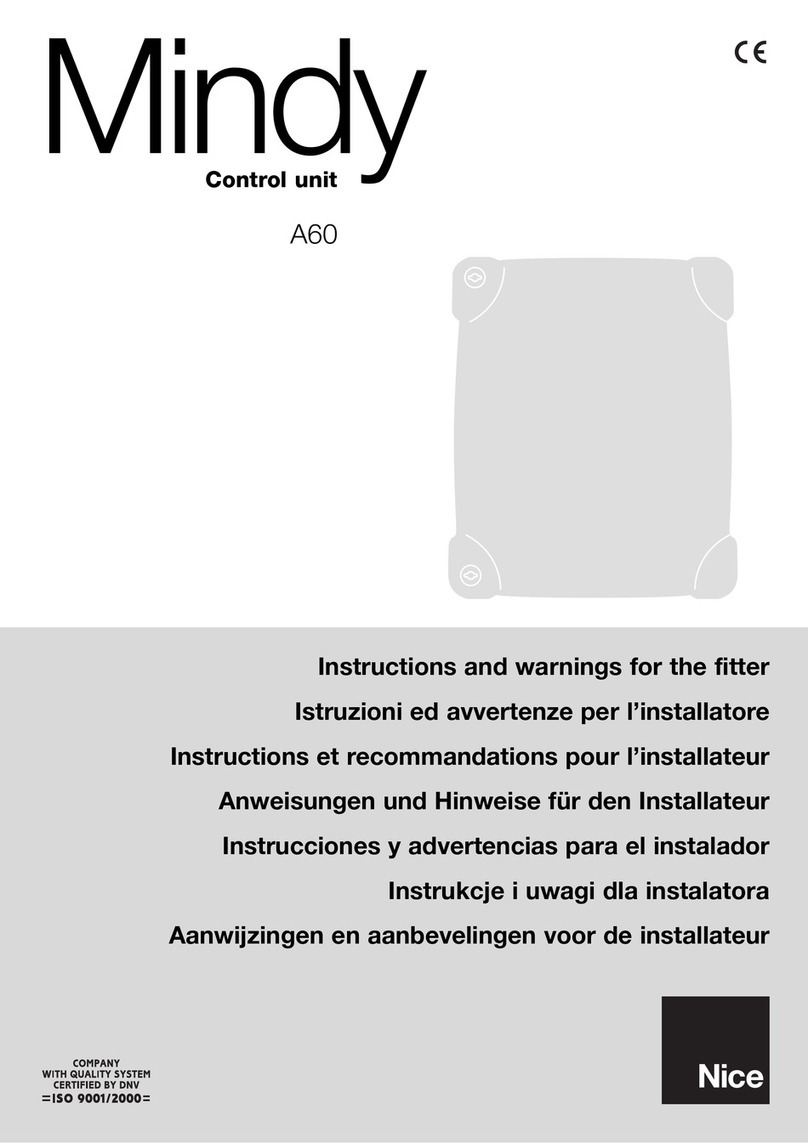
Nice
Nice mindy A60 Instructions and warnings

Befaco
Befaco KICKALL user manual
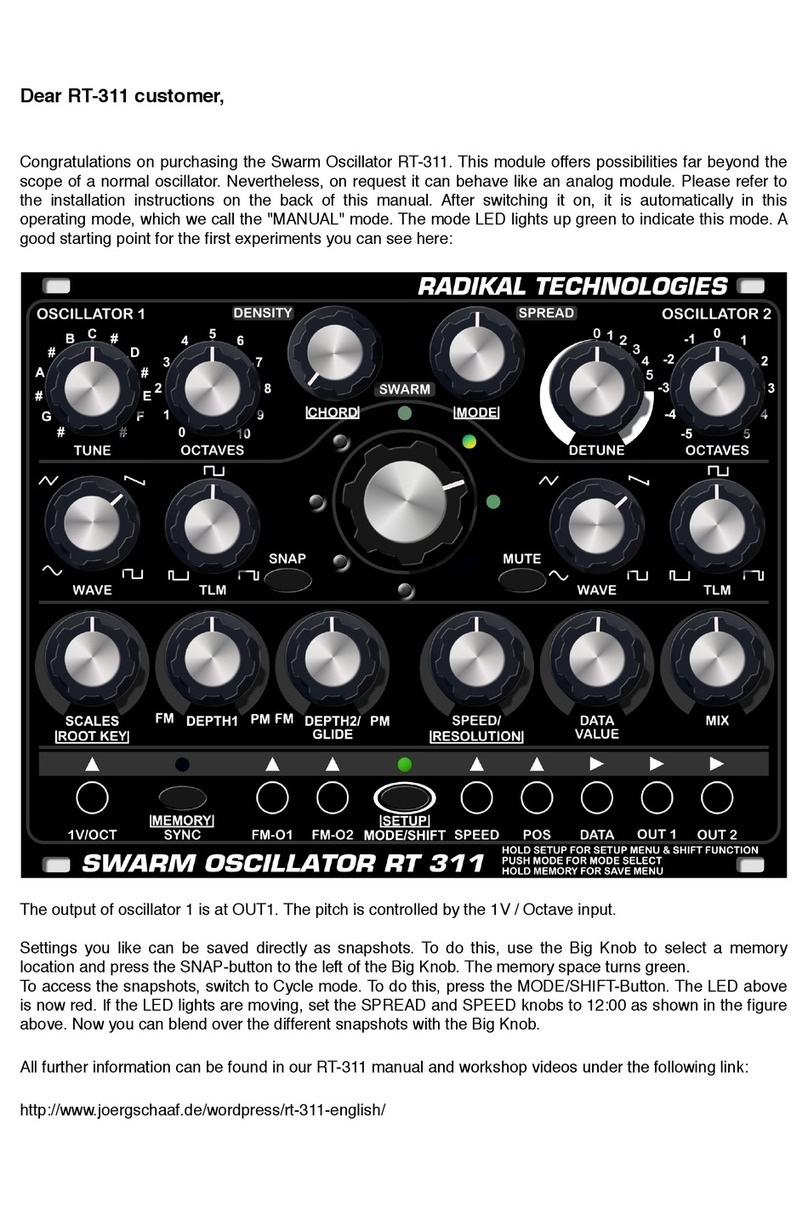
RADIKAL TECHNOLOGIES
RADIKAL TECHNOLOGIES Swarm Oscillator RT-311 quick start guide

Locomarine
Locomarine NMEA0183 TO ETHERNET CONVERTER installation manual
